
Our first stop was Chapel Trail Nature Preserve in Pembroke Pines, the next city north of us. As we pulled into the parking area we saw some birds gathered around a rainwater puddle.
Several Common Grackles were enjoying their baths.
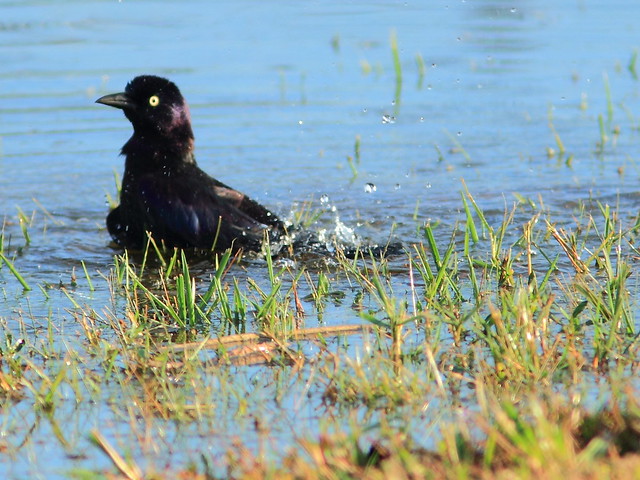

A White Ibis foraged among them. Since this is just a temporary body of water, I assume their prey to be insects and other invertebrates that were flooded out from the grass and underground.

Killdeers probed the perimeter of the puddle.

A lone male Mottled Duck dabbled in the puddle.

We set out on the boardwalk, which traverses a small wooded area, a couple of creeks or sloughs (some call them "slews") and a wet prairie containing several small lakes.
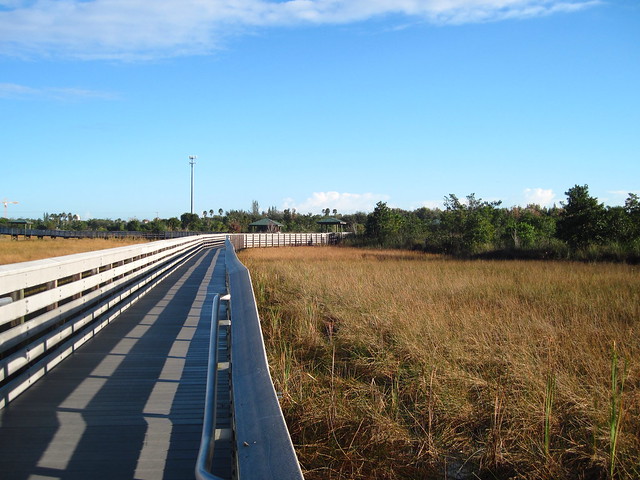

A soft-shell Turtle surfaced beneath the boardwalk, only its nose and eyes above the water.

Three Wood Storks seemed to ignore our presence.

A Northern Mockingbird perched nicely in great light.
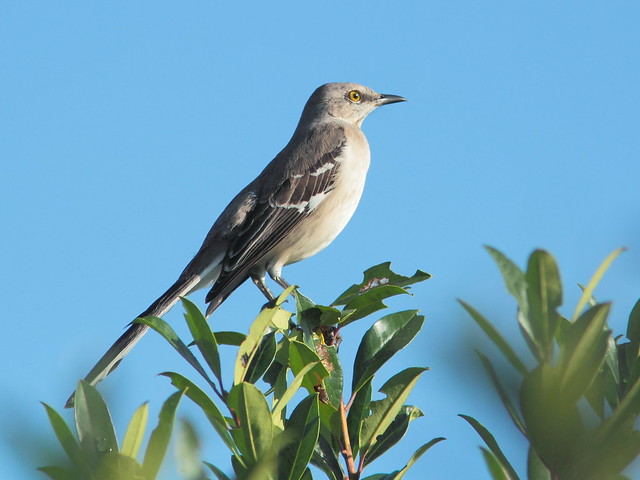
I was surprised to hear the call of an American Robin. It was rather far away on the top of a tall Melaleuca, which was in bloom. We see relatively few robins. Some years they never appear in our neighborhood, and when they do they are usually in large flocks. This one was alone, the first seen this winter.

As usual, Mary Lou got ahead of me on the boardwalk. She called my cell to say she had spotted a hawk perched on the boardwalk ahead of her. I hurried to get a look. At first I thought it was an immature Red-shouldered Hawk, which is a relatively common resident. Upon closer examination, I noted that its legs were shorter than those of a Red-shouldered, and its tail, instead of showing many narrow bands, had only a few wide ones. I thought it was a Broad-winged Hawk. But wait-- its body is long and cylindrical, and tail too long for a Buteo. It's an accipiter, an immature Cooper's Hawk.
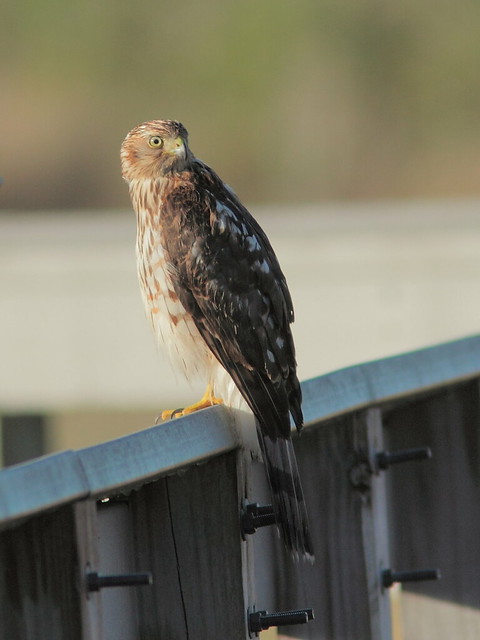
Later, an adult Cooper's Hawk flew overhead. Its big head, larger overall size, and rounded tail distinguish it from theSharp-shinned Hawk.
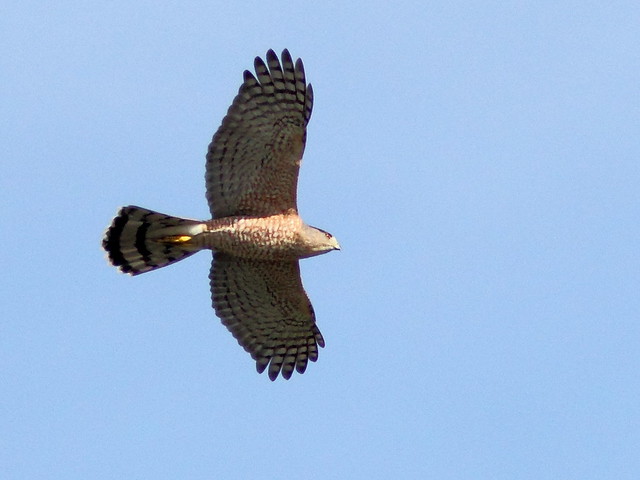
Several exotic and invasive Purple Swamphens were much in evidence. These birds were introduced near this location in the late 1990s, and have proliferated and extended their range northward despite a vigorous but futile program to exterminate them. In addition to a staple diet of roots and stems of water plants, they prey on the eggs and young of marsh birds. Since we arrived in 2004 we have seen fewer native gallinules at Chapel Trail -- in fact, not a single Purple Gallinule in more than three years.
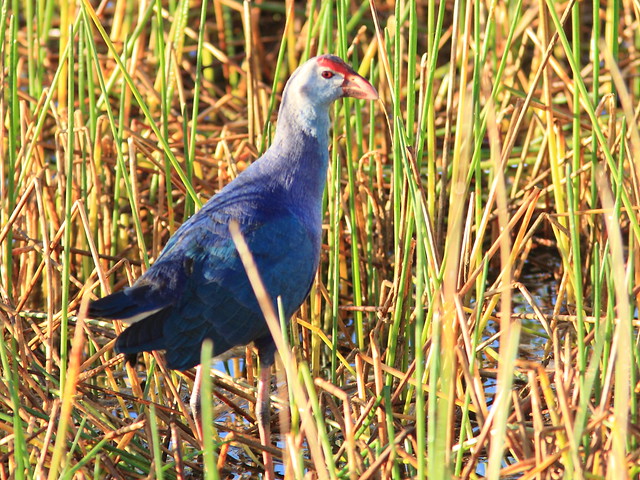

We had visited a few days earlier, just after arriving home from Illinois. Our target bird that day was a Florida specialty, one of our favorites, the Limpkin. We were not disappointed.
As we reached the far end of the boardwalk, a Limpkin flew in front of us and settled in the wet prairie.
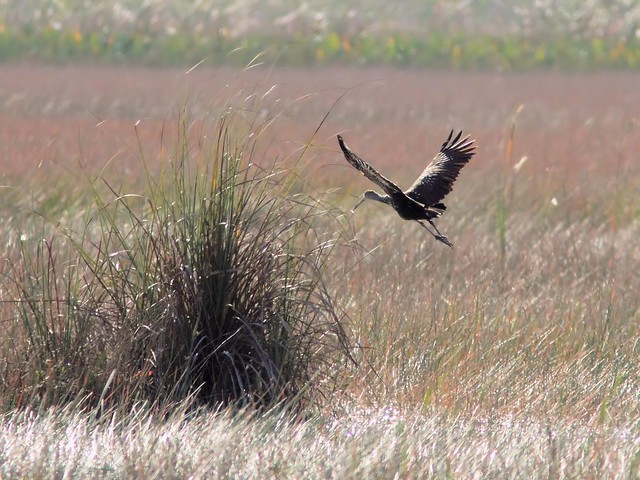
It was nearly hidden by the grass and sedges.
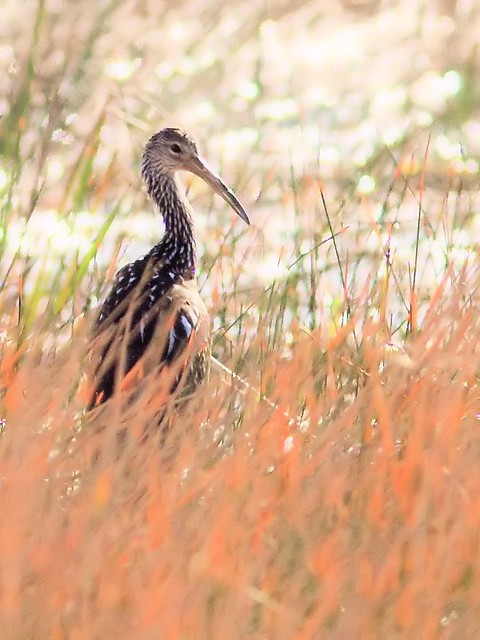
We thought that would be about our best view of the Limpkin, but it surprised us by flying up again and settling in a small tree.
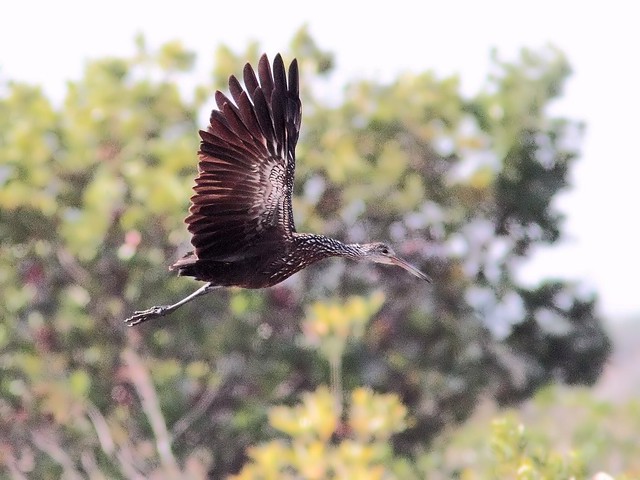
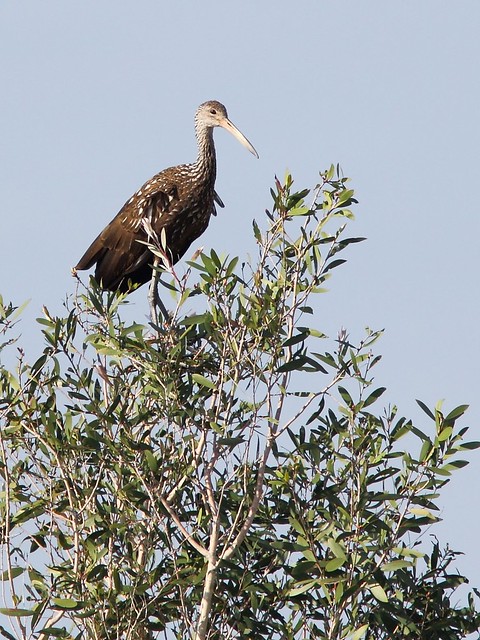
After posing for a moment, it flew towards us and right over my head. The nearest photos did not turn out well, as I had trouble keeping the bird in the camera viewfinder, so I stitched the ones I salvaged into this time-lapse sequence. (Click on the image to view it larger on black.)

Before going on the the post office, we stopped a couple of blocks away to check on the welfare of the local Bald Eagles. Their eggs were laid near the end of November and should hatch around New Years Day. We found one adult on the nest, fluffing its feathers, but it immediately settled down to incubate and was almost out of sight. Only the top of its head and tail were visible. Follow the ground observations and photos submitted by eagle watchers on my Pembroke Pines Bald Eagle nest monitoring FORUM.

Its mate (which, from her bulky look and high forehead, appears to be the female) was roosting in a tree adjacent to the nest tree. She was fluffing and preening, leading me to believe that the pair may have just finished exchanging incubation duties.
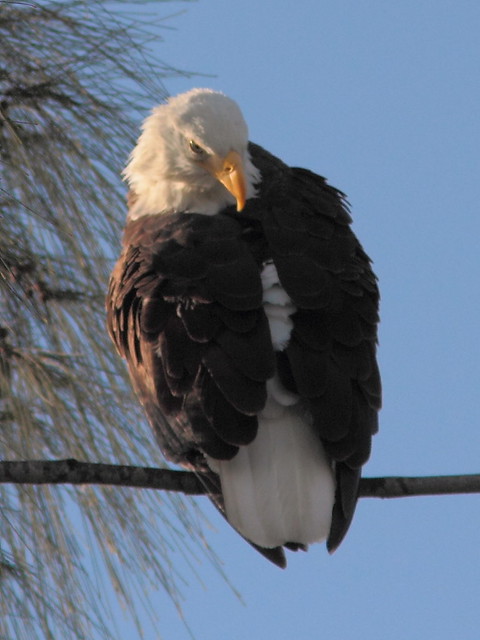
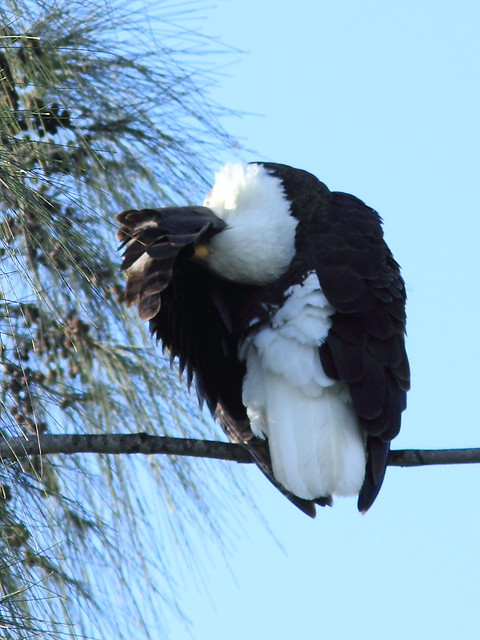
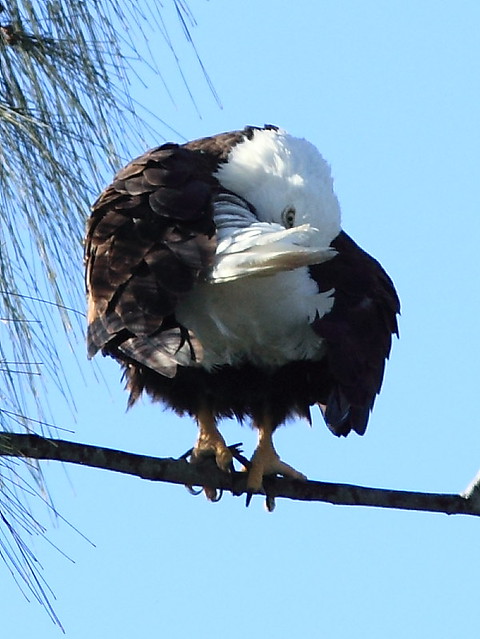
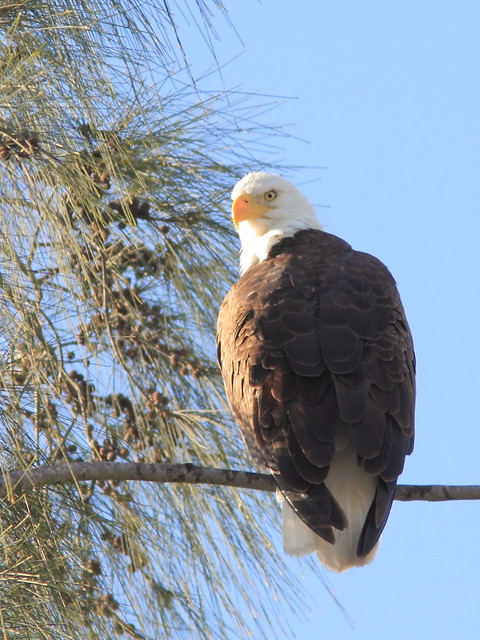
thank you for sharing nature's beauty today.
ReplyDeleteGreat bird and photos, Ken! I love the Ibis, Wood Stork, and the cool eagles shots. But they are all wonderful photos. Happy Birding!
ReplyDeleteGreat pictures of your walk! I haven't seen any Purple Swamp Hens in our area but I understand they're slowly expanding out of south Florida. Really nice shots of the Eagle!
ReplyDeleteGreat series!! Boom & Gary of the Vermilon River, Canada.
ReplyDeleteHello Ken
ReplyDeleteVery nice photo series showing some beautiful birds / animals we do not have in these latitudes.
Thank you showed them.
Hanne Bente
Another great post Ken! Nice captures of the Cooper's Hawk and the Limpkin. That Purple Swamphen certainly is a looker. To bad it's an invasive species. Love the wingspread landing shot ;-) Nice close-ups of the Bald Eagle too. It always amazes me what small branches they are able to perch upon!
ReplyDeleteThanks for that entertaining walk and talk Ken. You got some stupendous shots there - oh to have that light on a regular basis here. Lovely shot of the perched Cooper's Hawk too and good to see how to distinguish it from Sharp-shinned. Here with accipiters we only have to separate Sparrowhawk from Goshawk, vastly different sizes.
ReplyDeleteThat's what I call a fantastic day of birding. Great captures, Ken.. epecially those beautiful Eagles.
ReplyDeleteWow...I'd have probably forgotten all about the post office! What a grand day of birding. You saw more in that puddle than many people see on a planned day of birding to some famous birding spot! All your pictures are amazing, and the eagle is even better than amazing.
ReplyDeleteso much gorgeous bird shots I can´t even begin to comment on any. Well, anyway, as a photograher I certainly love the shots of the, seemingly, shy eagle. :)
ReplyDeleteA great series of birds and the eagle preening is very special. I have only ever seen photos of them perched and looking very majestic. Sad about the invasive birds. In my town we have recently noticed Sparrows and Mynas - both invasive species.
ReplyDeleteA wonderful post and your images are as fantastic as ever.
ReplyDeleteApologies for a lack of recent comments but I do pop by for a look quite often.
What a wonderful set of pictures.
ReplyDeleteAre the swamp-hens Australia? They look very similar to ours.
Cheers and thanks for linking to WBW - Stewart M - Melbourne
What a birdparadise you live in!
ReplyDeleteYour photos are soo good and interesting to see! Very well done!
Wish you a Merry Christmas and a Happy New Year!
Greetings Pia in Sweden
What wonderful sights you see on your way to the post office! Beautiful photography.
ReplyDelete
ReplyDeleteJust inside and to wish you a Merry Christmas and a Happy New Year :)
Christmas Greetings Hanne Bente
Thanks, all of you for visiting and for your kind comments.
ReplyDelete@Stewart-- According to Wikipedia,
"The Florida birds are mostly or entirely of the gray-headed race poliocephalus, native to the area around the Caspian Sea.
"There are 13 or more subspecies of the Purple Swamphen (depending on the authority) which differ mainly in plumage colour. The subspecies groups are: P. p. porphyrio in the Mediterranean, P. p. madagascariensis in Africa, P. p. poliocephalus in tropical Asia, P. p. melanotus in much of Australasia, P. p. indicus in Indonesia and P. p. pulverulentis in the Philippines. European birds are overall purple-blue, African and south Asian birds have a green back, and Australasian and Indonesian birds have black backs and heads.
"The Purple Swamphen was introduced to North America in the late 1990s due to avicultural escapes in the Pembroke Pines, Florida area. The birds multiplied and can now be found in many areas of southern Florida. Ornithological authorities consider it likely that the swamphen will become an established part of Florida's avifauna."
@Larry--
ReplyDeleteThese eagles have favored roost branches in trees adjacent to the nest, usually quite horizontal. As you noted, some are surprisingly small, given the size of the bird. The roosts are generally higher than the nest, which permits them to observe it. They pick the buds and shoots in order to keep the roosting area clear.